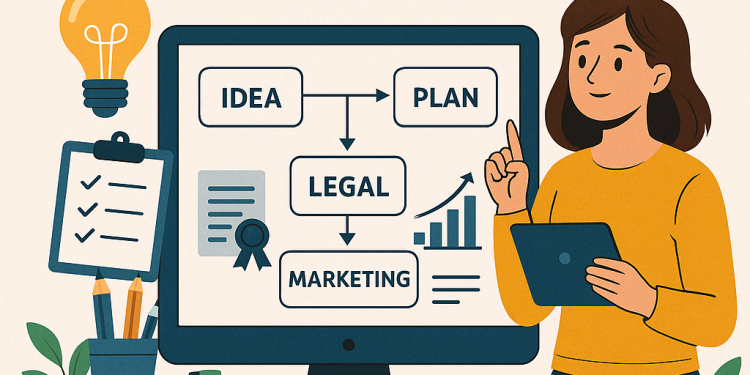Introduction: The American Dream Begins with a Small Business
For millions of people, the dream of entrepreneurship starts with a simple idea—and the USA is one of the best places in the world to bring that dream to life. From the bustling streets of New York to small towns in the Midwest, American startups are fueling the economy, driving innovation, and turning passions into profits. But turning your vision into a thriving company requires planning, paperwork, and persistence.
If you’re ready to take the leap, this small business guide will walk you through each step to start a business USA style—clear, actionable, and tailored for first-time founders.
1. Find Your Business Idea
Every great company begins with a problem to solve or a gap to fill. Start by asking yourself:
- What are you passionate about?
- What skills or experience do you have?
- Is there demand for your idea in the market?
Research trends, look at your local community, and don’t be afraid to get creative. Remember, small businesses range from food trucks to tech startups, cleaning services to handmade crafts.
2. Conduct Market Research
Before investing time and money, you need to understand your customers, competitors, and industry landscape.
- Analyze your target market: Who are your potential customers? Where do they live? What do they want?
- Study the competition: What are other businesses doing well? Where are their gaps?
- Validate your idea: Test it with friends, online surveys, or a soft launch.
Solid market research reduces risk and helps you refine your offering for better success.
3. Write a Solid Business Plan
A business plan is more than a document for banks or investors—it’s your roadmap. Your plan should include:
- Executive summary (a one-page business overview)
- Business description and mission
- Market analysis (target market and competitors)
- Products or services offered
- Marketing and sales strategy
- Management structure
- Startup and ongoing costs
- Financial projections
Tip: The Small Business Administration (SBA) offers free templates to help you get started.
4. Choose a Legal Structure
How you register your business impacts your taxes, liability, and paperwork. Common structures in the USA include:
- Sole Proprietorship: Easiest, but you’re personally liable for debts.
- Partnership: For businesses with two or more owners.
- Limited Liability Company (LLC): Flexible and protects your personal assets.
- Corporation (C-Corp or S-Corp): Best for larger startups or those seeking investors.
Pro Tip: Consult an accountant or legal advisor to choose the best structure for your goals.
5. Register Your Business
Business registration requirements vary by state, but typically involve:
- Registering your business name (check if it’s available in your state)
- Getting an Employer Identification Number (EIN) from the IRS (free and easy online)
- Registering for state and local taxes
- Obtaining any necessary business licenses or permits
Note: Some businesses (like food or childcare) require additional health or safety permits.
6. Set Up Your Finances
A common reason small businesses struggle is poor financial planning. Here’s what to do:
- Open a business bank account: Never mix personal and business finances.
- Set up accounting: Use bookkeeping software like QuickBooks, Wave, or Xero.
- Understand taxes: Research federal, state, and local tax requirements. Consider working with a CPA (Certified Public Accountant).
- Plan your budget: Know your startup costs, monthly expenses, and revenue goals.
7. Fund Your Business
Not every business needs a huge investment, but it’s important to know your options:
- Personal savings: The most common funding source.
- Bank loans: SBA-backed loans have lower rates for startups.
- Investors: Angel investors or venture capital for scalable startups.
- Crowdfunding: Platforms like Kickstarter or GoFundMe.
- Grants: Some nonprofits or government programs support new businesses (especially for minorities, women, and veterans).
Pro Tip: Start lean—focus on essentials and grow as revenue allows.
8. Build Your Brand and Online Presence
Branding is about more than a logo; it’s how people see and remember your business.
- Choose a business name that’s memorable and available as a .com domain.
- Design a professional logo (use affordable services like Canva or Fiverr if you’re on a budget).
- Build a simple website: Even a one-page site is better than none. Include contact info, what you offer, and your story.
- Set up social media: Pick platforms where your customers hang out (Instagram for food or fashion, LinkedIn for B2B, etc.).
- Claim your Google Business Profile: This helps locals find you on maps and search.
9. Develop a Marketing Strategy
No matter how great your business is, you need to attract customers. Start with:
- Local marketing: Flyers, partnerships with other businesses, attending local events.
- Online marketing: Social media posts, email newsletters, Google Ads, or Facebook ads.
- Content marketing: Blog posts, videos, or tutorials that answer customer questions.
- Word-of-mouth: Offer great service and encourage happy customers to leave reviews.
Focus on what works for your industry and budget—then track your results and adjust as needed.
10. Hire (or Outsource) as You Grow
You may start solo, but as you scale, you’ll need help:
- Employees: Hire for roles like sales, marketing, or customer service.
- Contractors: Use freelancers for web design, accounting, or delivery.
- Advisors/mentors: Connect with experienced entrepreneurs for guidance.
Tip: Use clear job descriptions, and always check references.
11. Manage Operations and Compliance
Stay organized from day one:
- Track income and expenses: Update your books weekly or monthly.
- Meet tax deadlines: Pay quarterly estimated taxes if required.
- Renew licenses and permits as needed.
- Get business insurance: Protects against lawsuits, property damage, or other risks.
12. Grow and Adapt
The best entrepreneurs are always learning and adjusting. After launch:
- Ask for feedback from customers and employees.
- Monitor trends in your industry and competitors.
- Expand thoughtfully: Add products, open new locations, or grow your online presence.
Set new goals, celebrate your milestones, and stay connected to your “why.”
13. Table: Small Business Startup Checklist
| Step | Key Action Points |
|---|---|
| Business Idea | Identify your passion, research demand |
| Market Research | Study target customers and competitors |
| Business Plan | Write a clear, realistic plan |
| Legal Structure | Choose and register (LLC, Corp, Sole Proprietor, etc.) |
| Business Registration | Register name, get EIN, required licenses |
| Finances | Open account, set up bookkeeping, learn taxes |
| Funding | Explore loans, grants, savings, investors |
| Branding & Online Presence | Logo, website, social media, Google Business Profile |
| Marketing | Local ads, digital marketing, content, word-of-mouth |
| Hiring | Employees, contractors, mentors |
| Compliance | Licenses, insurance, taxes |
| Growth | Gather feedback, watch trends, scale thoughtfully |
14. Resources for American Startups
Starting a small business in the USA can feel overwhelming, but there are tons of free (and low-cost) resources to help:
- Small Business Administration (SBA)
- SCORE Mentors
- U.S. Chamber of Commerce
- IRS Small Business Tax Center
- America’s SBDC Network
Conclusion: Your Journey Starts Today
Launching a business in the USA is a true adventure. While there are obstacles and paperwork along the way, there’s also immense opportunity. With a clear plan, a dash of courage, and the right guidance, your entrepreneurship story can become the next great American success.
Are you ready to turn your vision into reality? Use this guide, connect with other founders, and take your first step toward owning your future. Your small business could be the next local favorite—or maybe even a nationwide brand!


















































